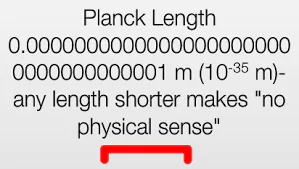 As science has developed and researchers have gotten the opportunity to explore the micro-world of atoms, an urge for new units of measurement has emerged. In 1889, a German physicist, Max Planck, introduced his system of lengths, which included many of the measurement units we operate with today, including the shortest length in the world: Planck length.
As science has developed and researchers have gotten the opportunity to explore the micro-world of atoms, an urge for new units of measurement has emerged. In 1889, a German physicist, Max Planck, introduced his system of lengths, which included many of the measurement units we operate with today, including the shortest length in the world: Planck length.

✅ AI Essay Writer ✅ AI Detector ✅ Plagchecker ✅ Paraphraser
✅ Summarizer ✅ Citation Generator
Providing someone with a visual image of such a small length is, perhaps, an impossible task. Planck length is only 1.6 x 10 meters squared by negative 35 meters; if you know the size of a proton, try to imagine something that would be 10-20 times smaller—and it will be Planck length (PhysLink.com). In case you are not familiar with mathematics, it means that Planck length is 1000000000000000000000 times smaller than a proton.
What is it needed for? When developing his system, Max Planck was trying to come up with a way to define measurement units that depended on constants of the universe, not on a system of measurement or relative lengths. Usually, we measure lengths either in feet or in meters, which often causes confusion; Planck was looking for units that would not depend on the way one measures something (FermiLab Today).
Planck length is a crucial component of the equation that describes the entropy in black holes, offered by Stephen Hawking and Jacob Bekenstein. In the theory of strings, it is considered that the Planck length corresponds to the size of the “strings,” of which all the particles in the standard model are thought to consist of (fromquarkstoquasars.com). Even if string theory is wrong, Planck length will not lose its value, because, as Planck said himself about his discoveries, “These necessarily retain their meaning for all times and for all civilizations, even extraterrestrial and non-human ones, and can therefore be designated as “natural units” (Fermilab Today).
Planck length is the smallest length among those that are known to humanity at present. It is 1.6 x 10 meters squared by negative 35 meters, which is about 10-20 times smaller than a proton. Max Planck developed this length as a measurement unit that would be independent from any measurement system, and would only depend on the constants of the universe. Planck length is now actively used in quantum physics—particularly, in the theory of strings—and it seems that its value to science will never fade.
References
“What is Planck Length? What is Planck Time?”PhysLink.com. N.p., n.d. Web. 24 Feb. 2015
“Planck Length, Minimal Length?” Fermilab Today. N.p., n.d. Web. 24 Feb. 2015.
“The Smallest Possible Length.” From Quarks to Quasars. N.p., 03 Apr. 2014. Web. 24 Feb. 2015.
Follow us on Reddit for more insights and updates.





Comments (0)
Welcome to A*Help comments!
We’re all about debate and discussion at A*Help.
We value the diverse opinions of users, so you may find points of view that you don’t agree with. And that’s cool. However, there are certain things we’re not OK with: attempts to manipulate our data in any way, for example, or the posting of discriminative, offensive, hateful, or disparaging material.